Assessment of Soil Salinization Risk by Remote Sensing-Based Ecological Index (RSEI) in the Bosten Lake Watershed, Xinjiang in Northwest China
Abstract
1. Introduction
2. Overview of the Study Area
3. Materials and Methods
3.1. Data Sources
3.2. Selection and Calculation of Risk Assessment Factors for Soil Salinization
- Land use/land cover
- Salt index
- Normalized difference vegetation index
- Landscape morphology
3.3. Integrated Risk Assessment of Soil Salinization
4. Results and Analysis
4.1. Single-Factor Assessment of Soil Salinization Risk in the Bosten Lake Watershed
4.1.1. Soil Salinization Risk Assessment in Terms of LULC Types
4.1.2. Soil Salinization Risk Assessment in Terms of SI
4.1.3. Soil Salinization Risk Assessment in Terms of NDVI
4.1.4. Soil Salinization Risk Assessment in Terms of Topography
4.2. Integrated Assessment of Soil Salinization Risk in the Bosten Lake Watershed
5. Discussion
6. Conclusions
- (1)
- A four period (1990, 2000, 2010, and 2020) RS dataset on soil salinization allowed for the accurate classification of the land use/land cover types, with an overall classification accuracy of greater than 90% and kappa values of >0.90, and the salt index (SI), an RS-derived risk factor of soil salinization, was significantly correlated with the actual measured salt content of the surface soils.
- (2)
- The RS-derived elevation and normalized difference vegetation index (NDVI) were significantly correlated with the SI-T.
- (3)
- An integrated risk assessment model was constructed for the soil salinization risk in the Bosten Lake watershed, which calculated the integrated risk index values and classified them into four risk levels: low risk, medium risk, high risk, and extremely high risk.
- (4)
- Due to the combined effect of the surface water area and terrain, the soil salinization risk gradually decreased from the lake to the surrounding areas, while the corresponding spatial range increased in order of decreasing risk. The areas with different levels of soil salinization risk in the study area during the last 30 years were ranked in decreasing order of medium risk > high risk > extremely high risk > low risk.
Author Contributions
Funding
Institutional Review Board Statement
Informed Consent Statement
Data Availability Statement
Acknowledgments
Conflicts of Interest
References
- Akter, F.; Bishop, T.; Vervoort, R.W. Space-time modelling of groundwater level and salinity. Sci. Total Environ. 2021, 776, 145865. [Google Scholar] [CrossRef] [PubMed]
- Khajehzadeh, M.; Afzali, S.F.; Honarbakhsh, A.; Ingram, B. Remote sensing and gis-based modeling for predicting soil salinity at the watershed scale in a Semi-arid region of Southern Iran. Arab. J. Geosci. 2022, 15, 423. [Google Scholar] [CrossRef]
- Wang, Z.; Zhang, F.; Zhang, X.; Chan, N.W.; Wang, Y. Regional suitability prediction of soil salinization based on remote-sensing derivatives and optimal spectral index. Sci. Total Environ. 2021, 775, 145807. [Google Scholar] [CrossRef] [PubMed]
- Wang, X.; Zhang, F. Extracting soil salinization information with a fractional-order filtering algorithm and grid-search support vector machine (GS-SVM) model. Int. J. Remote Sens. 2020, 41, 953–973. [Google Scholar] [CrossRef]
- Berdimuratov, M.K.; Lyashko, S.I.; Nomirovskii, D.A. Modeling and optimization of salinization of irrigated soil. J. Math. Sci. 2020, 96, 20–30. [Google Scholar] [CrossRef]
- Wang, R.Z. Plant functional types and their ecological responses to salinization in saline grasslands, Northeastern China. Photosynthetica 2004, 42, 511–519. [Google Scholar] [CrossRef]
- Wang, X.; Zhang, F.; Ding, J.; Kung, H.-t.; Latif, A. Estimation of soil salt content in the Ebinur Lake Wetland National Nature Reserve (ELWNNR), Northeast China based on the Bootstrap-BP neural network model and optimal spectral index. Sci. Total Environ. 2004, 615, 918–930. [Google Scholar] [CrossRef]
- Zhou, X.; Zhang, F.; Liu, C.; Kung, H.T.; Johnson, V.C. Soil salinity inversion based on novel spectral index. Environ. Earth Sci. 2021, 80, 501. [Google Scholar] [CrossRef]
- Masoud, A.A.; Koike, K. Arid land salinization detected by remotely-sensed land cover changes: A case study in the Siwa region, NW Egypt. J. Arid. Environ. 2006, 66, 151–167. [Google Scholar] [CrossRef]
- Qi, G.; Chang, C.; Yang, W.; Gao, P.; Zhao, G. Soil salinity inversion in coastal corn planting areas by the satellite-uav-ground integration approach. Remote Sens. 2021, 13, 3100. [Google Scholar] [CrossRef]
- Taylor, G.M.R. Pharmacogenetics of the human beta-adrenergic receptors. Pharm. J. 2007, 7, 29–37. [Google Scholar] [CrossRef] [PubMed]
- Chen, H.; Zhao, G.; Chen, J.; Wang, R.; Gao, M. Remote sensing inversion of saline soil salinity based on modified vegetation index in estuary area of Yellow River. Trans. Chin. Soc. Agric. Eng. 2015, 31, 107–114. (In Chinese) [Google Scholar]
- Bin, L.; Wang, Z.; Liang, Z.; Chi, C. Quality of Groundwater in Soil Areas in Da’an City and Soil Salinization Risk of Using the Water for Irrigation. J. Ecol. Rural Environ. 2006, 22, 20–24, 61. (In Chinese) [Google Scholar]
- Bui, E.N.; Henderson, B.L. Vegetation indicators of salinity in northern Queensland. Austral Ecol. 2003, 28, 539–552. [Google Scholar] [CrossRef]
- Muhetaer, N.; Nurmemet, I.; Abulaiti, A.; Xiao, S.; Zhao, J. A quantifying approach to soil salinity based on a radar feature space model using alos palsar-2 data. Remote Sens. 2022, 14, 363. [Google Scholar] [CrossRef]
- Liu, D. Soil moisture and salinity inversion based on new remote sensing index and neural network at a salina-alkaline wetland. Water 2021, 13, 2762. [Google Scholar]
- Zhang, X.; Huang, B. Prediction of soil salinity with soil-reflected spectra: A comparison of two regression methods. Sci. Rep. 2019, 9, 5067. [Google Scholar] [CrossRef]
- Song, C.-C.; Deng, W.; Li, Q.-S.; Wang, Z.C.; Zhang, G.H. Techniques of Controlling Secondary Soil Salinization in the West of Songnen Plain. Sci. Geogr. Sin. 2002, 22, 610–614. (In Chinese) [Google Scholar]
- Yan, Y.; Quanjiu, W. Analysis Water and Salt Transport Characteristic of Irrigation with Saline Water on Alkaline and Saline Soil. J. Soil Water Conserv. 2008, 22, 13–19. (In Chinese) [Google Scholar]
- Wallace, R.N.; Hope, B.K. Quantitative consideration of ecosystem characteristics in an ecological risk assessement: A case study. Hum. Ecol. Risk Assess. 2002, 8, 1805–1814. [Google Scholar] [CrossRef]
- Efroymson, R.A.; Murphy, D.L. Ecological risk assessment of multimedia hazardous air pollutants: Estimating exposure and effects. Sci. Total Environ. 2001, 274, 219–230. [Google Scholar] [CrossRef]
- Naito, W.; Miyamoto, K.; Nakanishi, J.; Masunaga, S.; Bartell, S.M. Application of an ecosystem model for aquatic ecological risk assessment of chemicals for a Japanese lake. Water Res. 2002, 36, 1–14. [Google Scholar] [CrossRef]
- Sungur, A.; Vural, A.; Gundogdu, A.; Soylak, M. Effect of antimonite mineralization area on heavy metal contents and geochemical fractions of agricultural soils in gümühane province, turkey. Catena 2020, 184, 104255. [Google Scholar] [CrossRef]
- Vural, A.; Akpinar, İ.; Sipahi, F. Mineralogical and Chemical Characteristics of Clay Areas, Gümüşhane Region (NE Turkey), and Their Detection Using the Crósta Technique with Landsat 7 and 8 Images. Nat. Resour. Res. 2021, 30, 3955–3985. [Google Scholar] [CrossRef]
- Zhang, Y.; Zhang, F.; Zhou, M.; Li, X.-H.; Ren, Y.; Wang, Y. Landscape ecological risk assessment and its spatio-temporal variations in Ebinur Lake region of inland arid area. Chin. J. Appl. Ecol. 2016, 27, 233–242. (In Chinese) [Google Scholar]
- Xi, C.; Wu, J.; Qi, H. Simulation of climate change impacts on streamflow in the Bosten Lake basin using an artificial neural network model. J. Hydrol. Eng. 2008, 13, 180–183. [Google Scholar]
- Wang, X.; Zhang, F.; Kung, H.T.; Johnson, V.C. New methods for improving the remote sensing estimation of soil organic matter content (SOMC) in the ebinur lake wetland national nature reserve (elwnnr) in Northwest China. Remote Sens. Environ. 2018, 218, 104–118. [Google Scholar] [CrossRef]
- Tripathi, N.K.; Rai, B.K.; Dwivedi, P. Spatial modeling of soil alkalinity in GIS environment using IRS data. In Proceedings of the 18th Asian Conference on Remote Sensing, Kuala Lumpur, Malaysia, 20–24 October 1997; pp. 81–86. [Google Scholar]
- Wang, F.; Ding, J.; Wu, M. Remote sensing monitoring models of soil salinization based on NDVI-SI feature space. Trans. Chin. Soc. Agric. Eng. 2010, 26, 168–173. [Google Scholar]
- Wang, Z.; Li, G.; Li, X.; Shan, S.; Zhang, J.; Li, S.; Fan, J. Characteristics of moisture and salinity of soil in Taklimakan desert, China. Water Sci. Technol. A J. Int. Assoc. Water Pollut. Res. 2012, 66, 1162–1170. [Google Scholar] [CrossRef][Green Version]
- Fuchsman, P.; Lyndall, J.; Bock, M.; Lauren, D.; Capdevielle, M. Terrestrial ecological risk evaluation for triclosan in land-applied biosolids. Integr. Environ. Assess. Manag. 2010, 6, 405–418. [Google Scholar] [CrossRef]
- Zhao, J. “Interim regulations on ecological functional area” is published by SEPA (state environmental protection administration). China Econ. Trade Her. 2002, 19, 41. (In Chinese) [Google Scholar]
- Li, Z.; Li, W.; Shi, H.; Jia, X. Gray Model for Ecological Risk Assessment and Its Application in Salinization Oasis Agroecosystem. J. Desert Res. 2002, 22, 617–622. (In Chinese) [Google Scholar]
- Yao, J.; Yang, J.; Chen, X.; Yu, S.; Li, X. Evaluating soil salinization risk in typical coastal reclaimed regions in North Jiangsu Province. Chin. J. Eco-Agric. 2010, 18, 1000–1006. (In Chinese) [Google Scholar] [CrossRef]
- Liu, J.; Zhang, L.; Dong, T.; Wang, J.; Fan, Y.; Wu, H.; Geng, Q.; Yang, Q.; Zhang, Z. The applicability of remote sensing models of soil salinization based on feature space. Sustainability 2021, 13, 13711. [Google Scholar] [CrossRef]
- Qin, X.; Kong, C.; Ren, Y. The application of remote sensing technology to soil salinization in yanqi basin. Lect. Notes Electr. Eng. 2012, 113, 891–896. [Google Scholar]
- Liu, Y.F.; Cao, Y.L.; Ouyang, Z.P. Information statistical analysis of influencing factors of soil salinization in Yanqi Basin. Environ. Sci. Technol. 2010, 33, 23–27. [Google Scholar]
- Yuan, X.; Yang, D.H. Study on the aqueous environment problems of the Bosten lake, Xinjiang. Arid. Zone Res. 2008, 497, 571–581. [Google Scholar]
- Wang, S.; Wang, S. Land use/land cover change and their effects on landscape patterns in the Yanqi Basin, Xinjiang (China). Environ. Monit. Assess. 2013, 185, 9729–9742. [Google Scholar] [CrossRef]

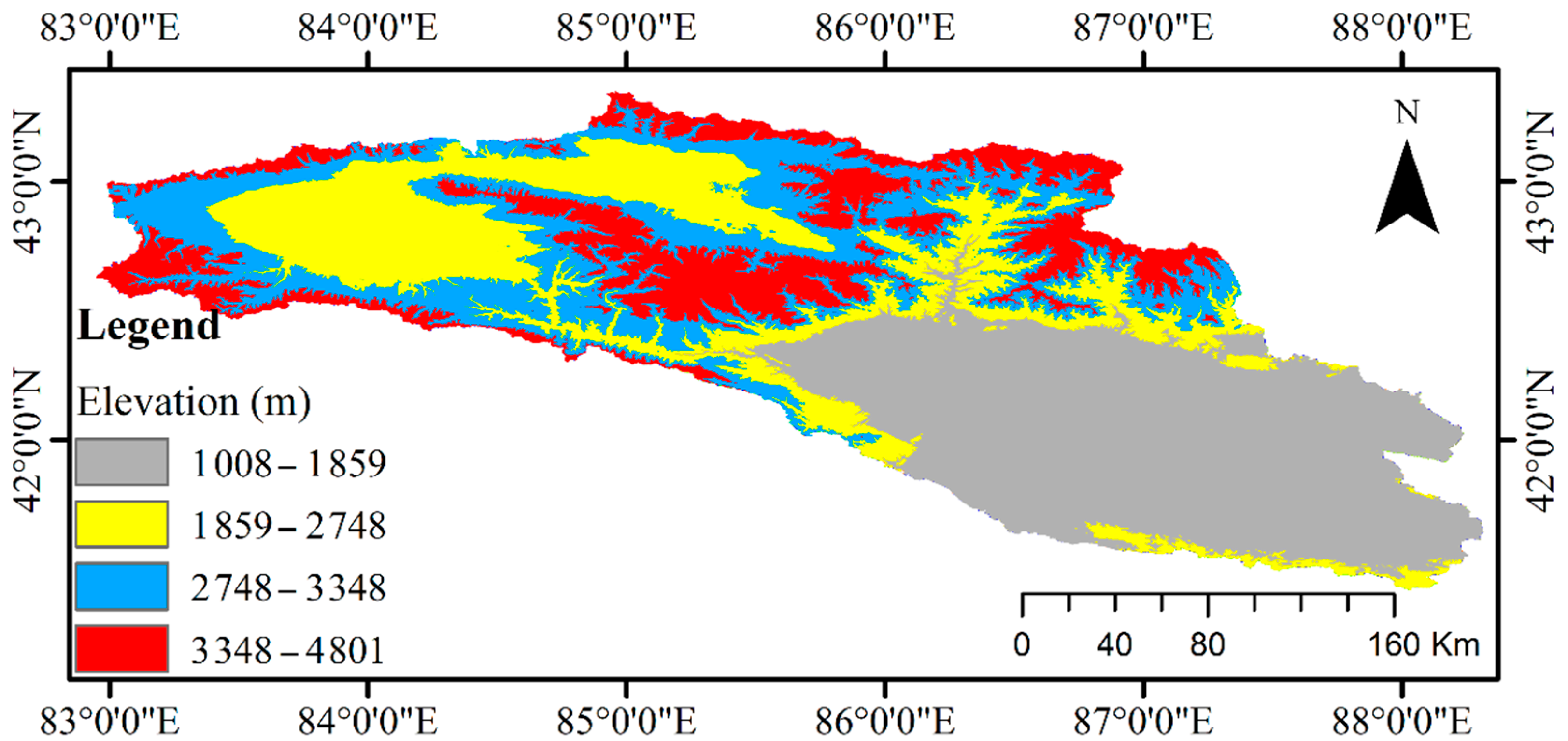
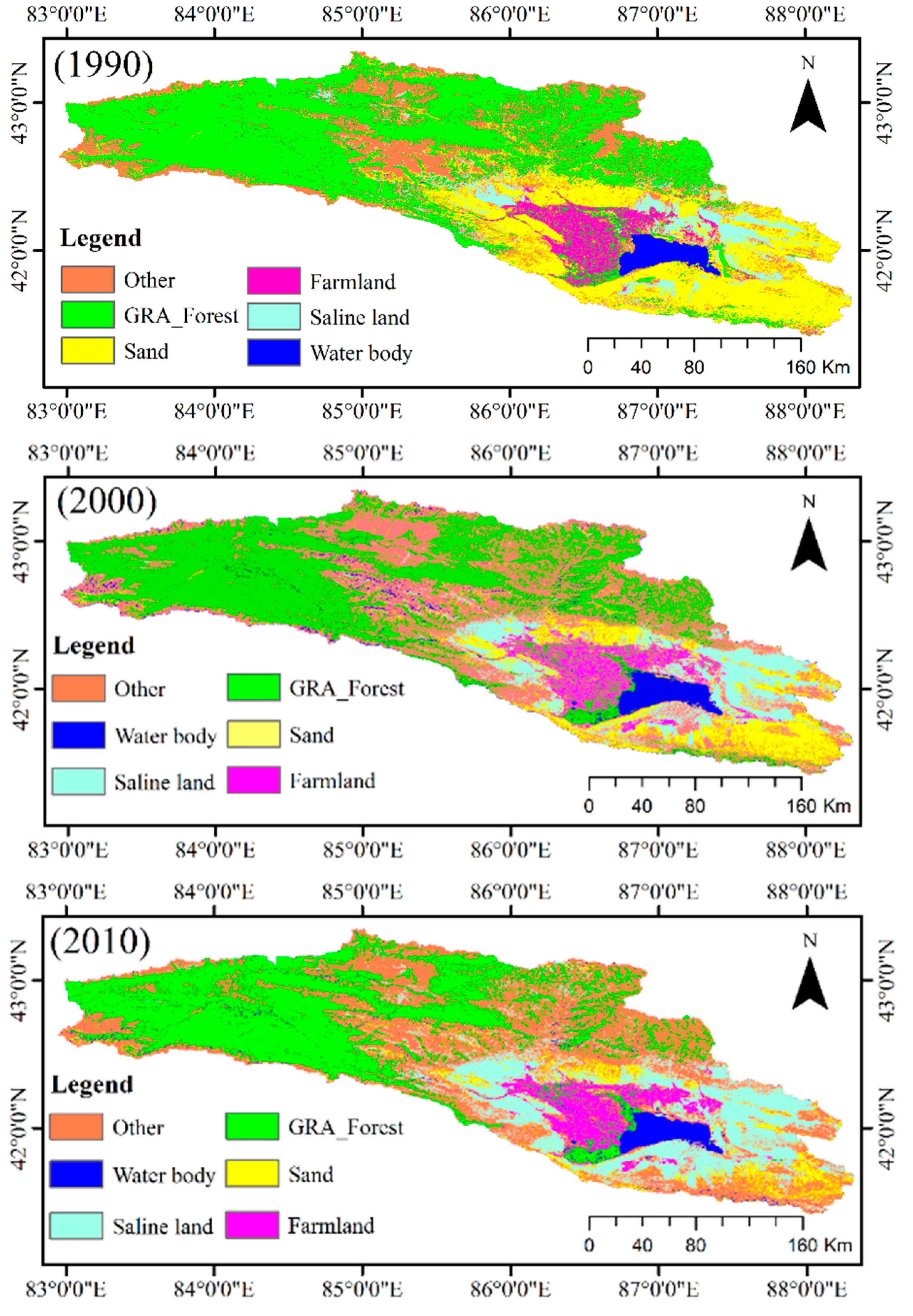
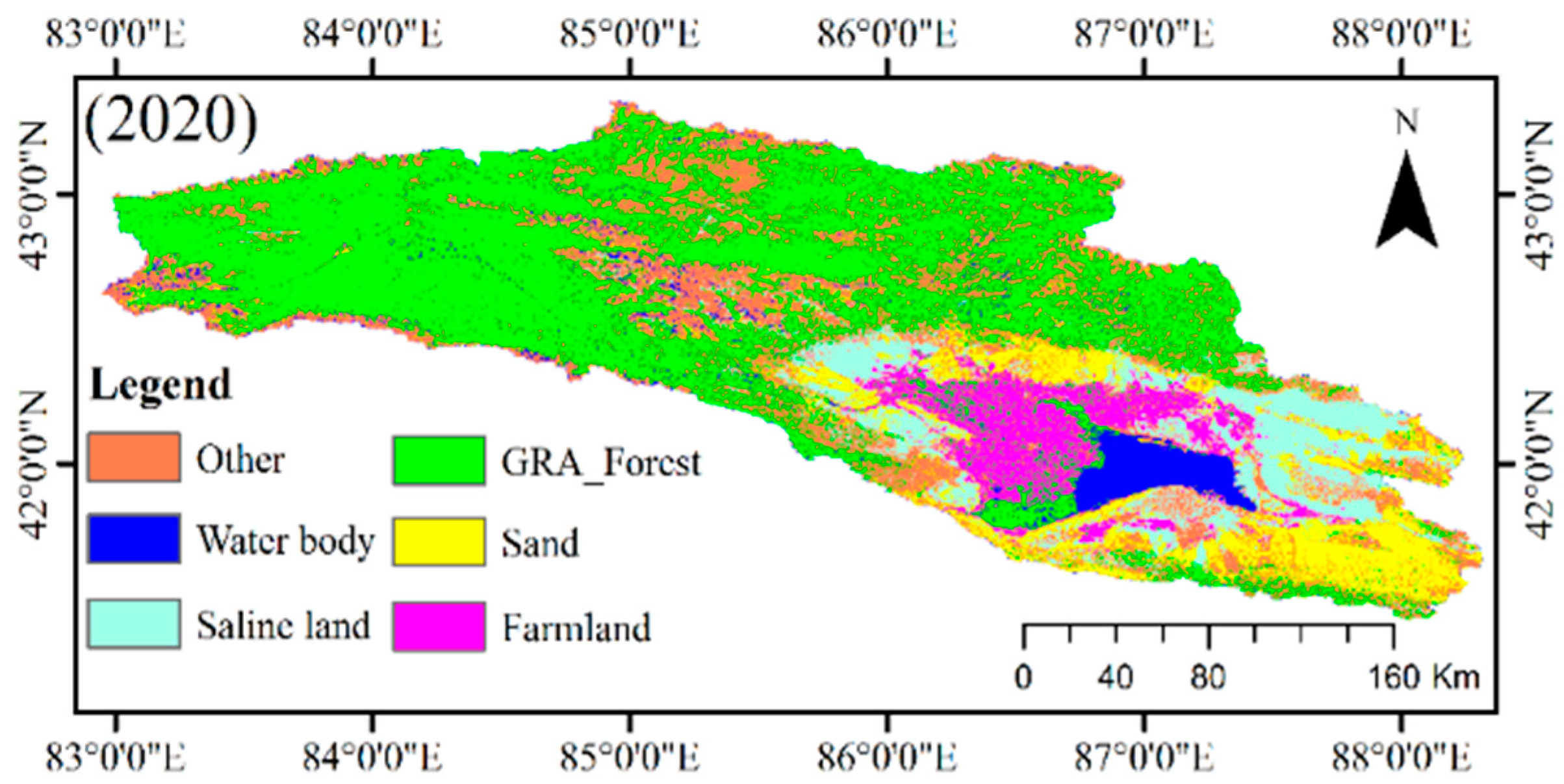
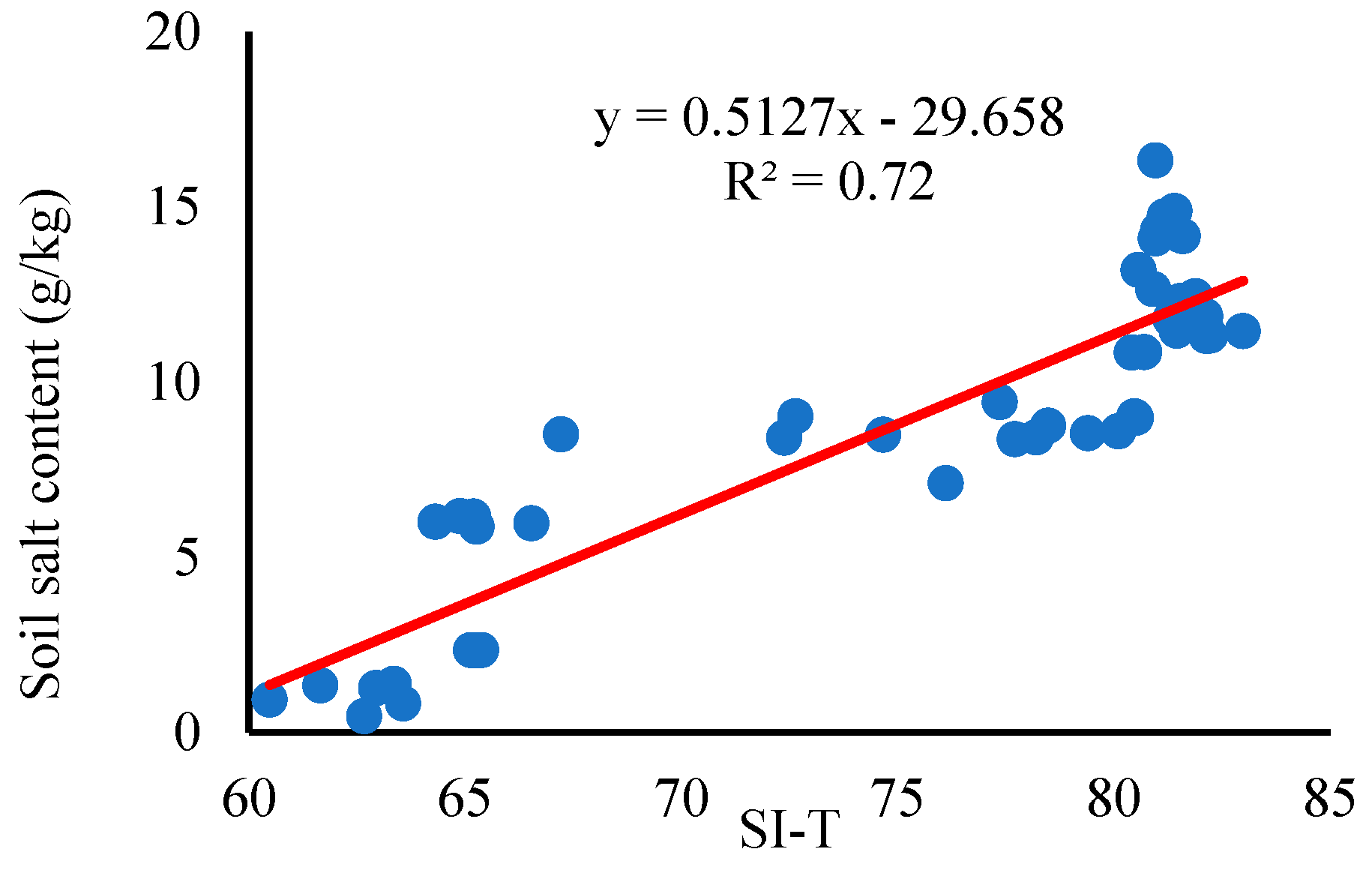

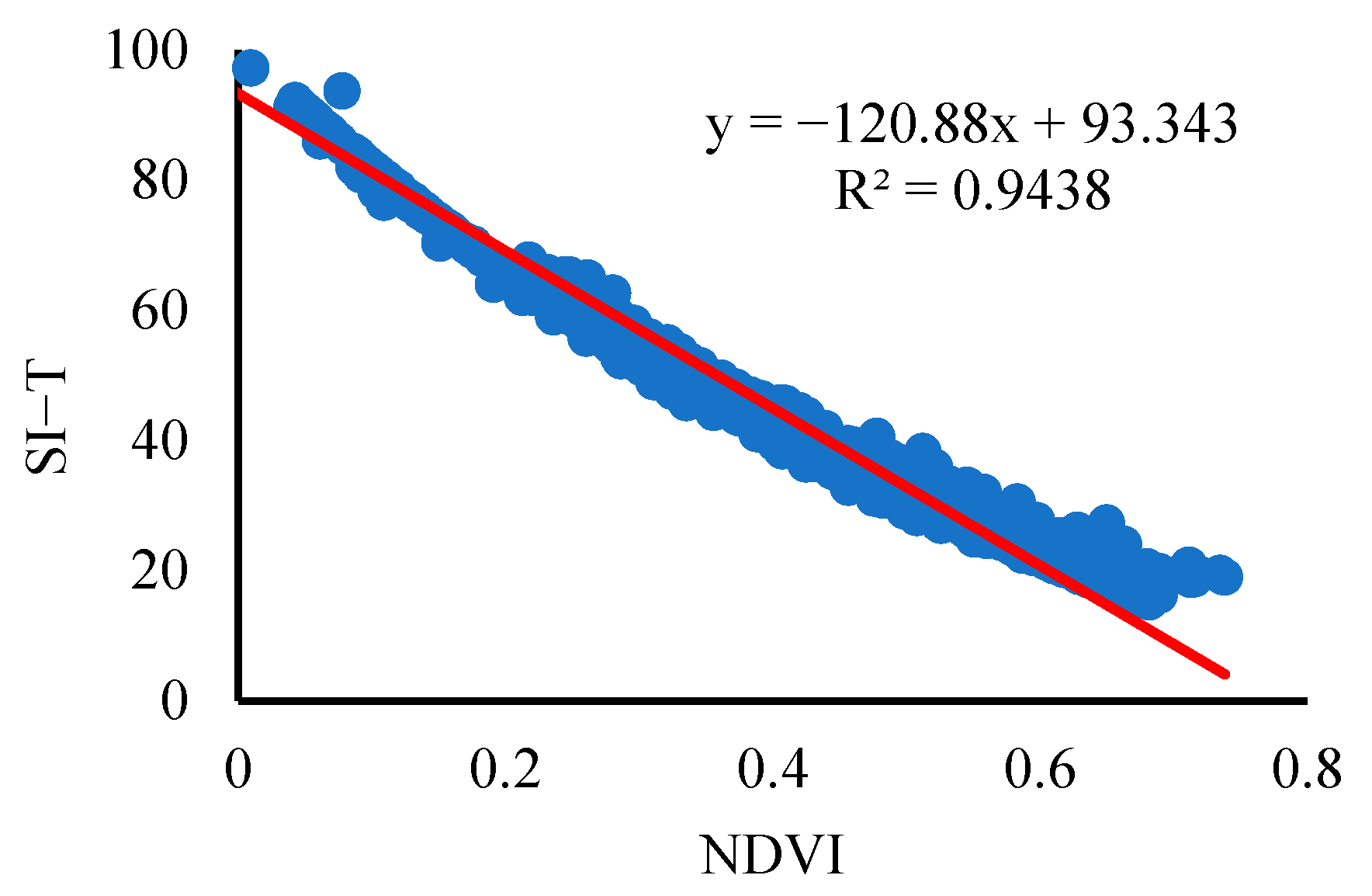
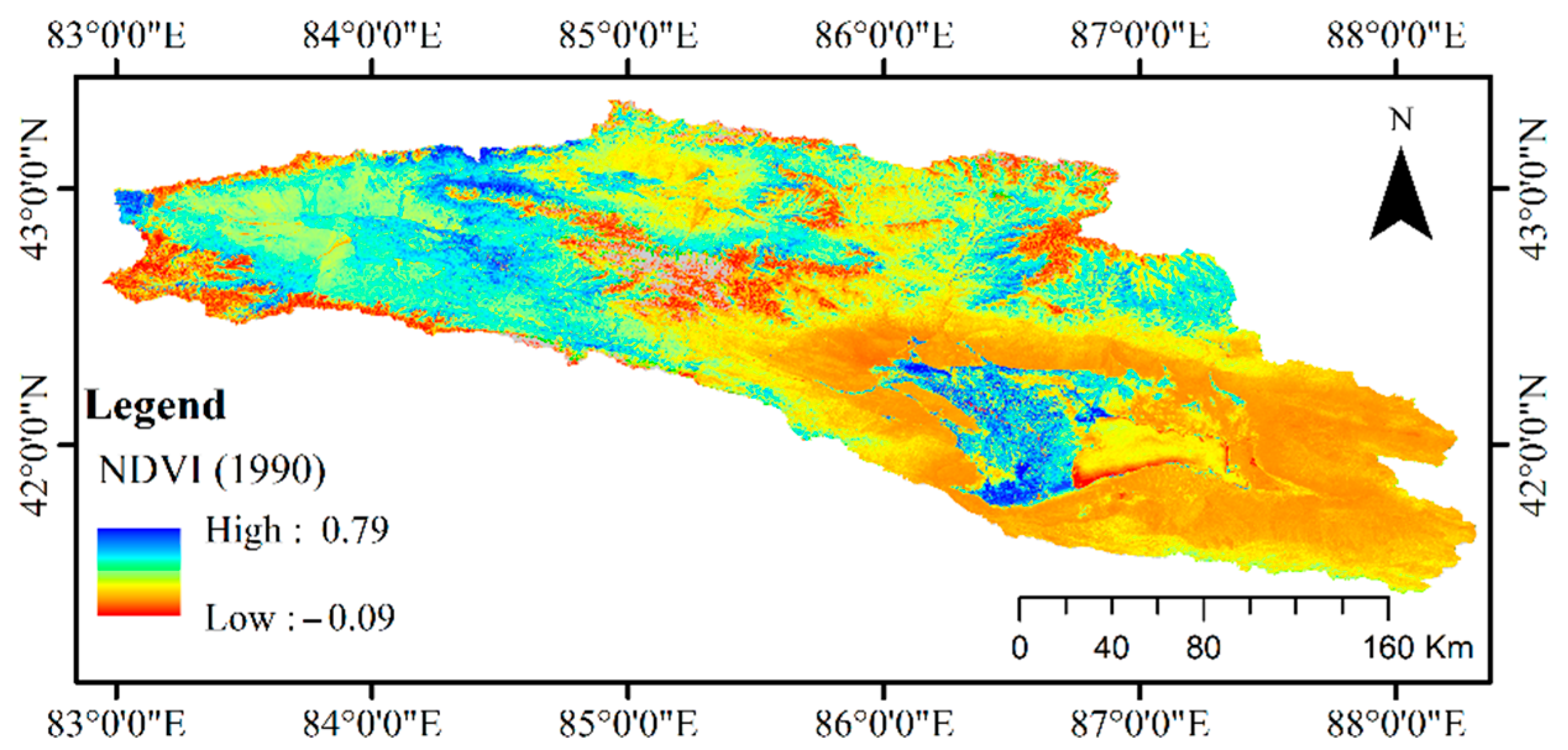




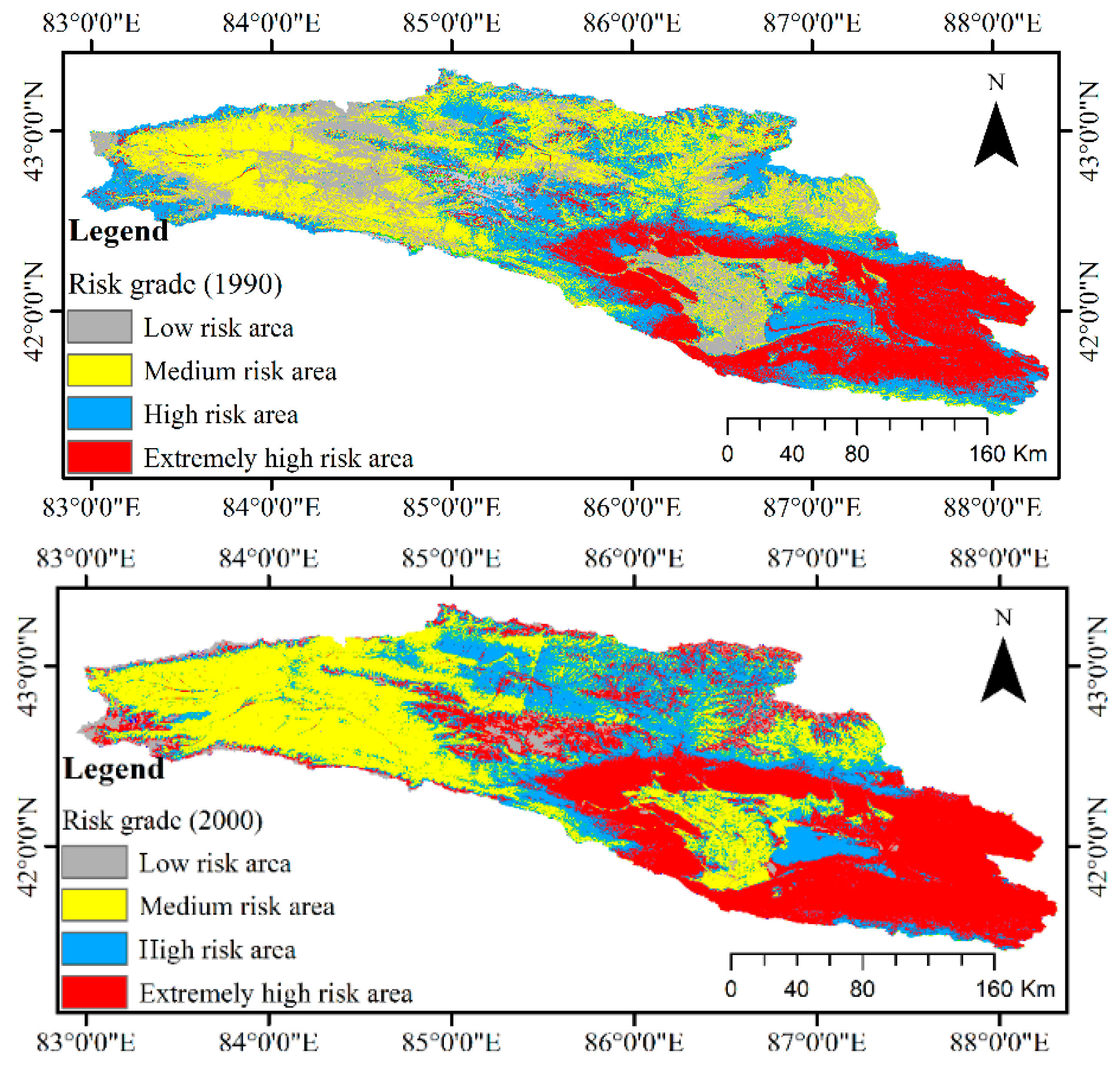
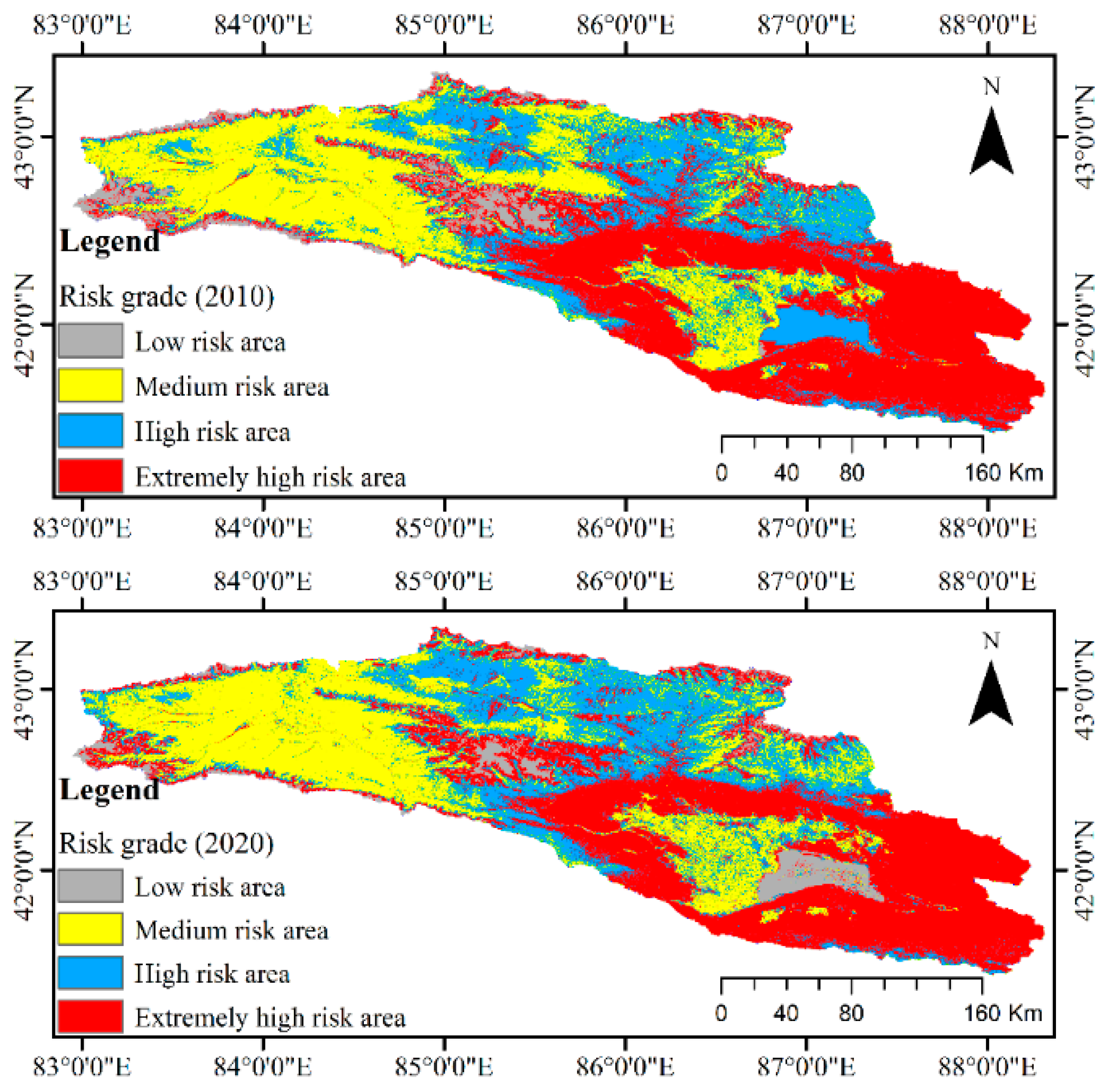
| Risk Grade | Land Use/Cover Type | Normalized Vegetation Index/% | Normalized Salinity Index/% | Elevation/m | Assignment |
|---|---|---|---|---|---|
| Low risk area | Water body, Forest-grass land | 80–100 | 0–20 | 1008~1859 | 1 |
| Medium risk area | Desert, Other land | 60–80 | 20–40 | 1859~2748 | 2 |
| High risk area | Wetland | 40–60 | 40–60 | 2748~3348 | 3 |
| Extremely high risk | Saline land | 20–40 | 60–80 | 3348~4801 | 4 |
| Year | Total Accuracy/% | Kappa |
|---|---|---|
| 1990 | 97.44 | 0.97 |
| 2000 | 97.80 | 0.97 |
| 2010 | 98.23 | 0.97 |
| 2020 | 96.44 | 0.96 |
| Risk Grade | 1990 | 2000 | 2010 | 2020 | ||||
|---|---|---|---|---|---|---|---|---|
| Area/km2 | Ratio/% | Area/km2 | Ratio/% | Area/km2 | Ratio/% | Area/km2 | Ratio/% | |
| Low risk area | 5350.13 | 8.97 | 3561.19 | 5.97 | 1902.33 | 3.19 | 2222.5 | 3.73 |
| Medium risk area | 25,891.49 | 43.43 | 24,178.98 | 40.55 | 27,629.50 | 46.34 | 26,632.15 | 44.67 |
| High risk area | 17,140.50 | 28.75 | 16,972.05 | 28.46 | 16,140.50 | 27.07 | 18,475.76 | 30.99 |
| Extremely high risk area | 11,234.35 | 18.84 | 14,904.23 | 25.01 | 13,644.14 | 22.88 | 11,683.11 | 19.59 |
Publisher’s Note: MDPI stays neutral with regard to jurisdictional claims in published maps and institutional affiliations. |
© 2022 by the authors. Licensee MDPI, Basel, Switzerland. This article is an open access article distributed under the terms and conditions of the Creative Commons Attribution (CC BY) license (https://creativecommons.org/licenses/by/4.0/).
Share and Cite
Hou, J.; Rusuli, Y. Assessment of Soil Salinization Risk by Remote Sensing-Based Ecological Index (RSEI) in the Bosten Lake Watershed, Xinjiang in Northwest China. Sustainability 2022, 14, 7118. https://doi.org/10.3390/su14127118
Hou J, Rusuli Y. Assessment of Soil Salinization Risk by Remote Sensing-Based Ecological Index (RSEI) in the Bosten Lake Watershed, Xinjiang in Northwest China. Sustainability. 2022; 14(12):7118. https://doi.org/10.3390/su14127118
Chicago/Turabian StyleHou, Jiawen, and Yusufujiang Rusuli. 2022. "Assessment of Soil Salinization Risk by Remote Sensing-Based Ecological Index (RSEI) in the Bosten Lake Watershed, Xinjiang in Northwest China" Sustainability 14, no. 12: 7118. https://doi.org/10.3390/su14127118
APA StyleHou, J., & Rusuli, Y. (2022). Assessment of Soil Salinization Risk by Remote Sensing-Based Ecological Index (RSEI) in the Bosten Lake Watershed, Xinjiang in Northwest China. Sustainability, 14(12), 7118. https://doi.org/10.3390/su14127118





